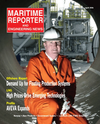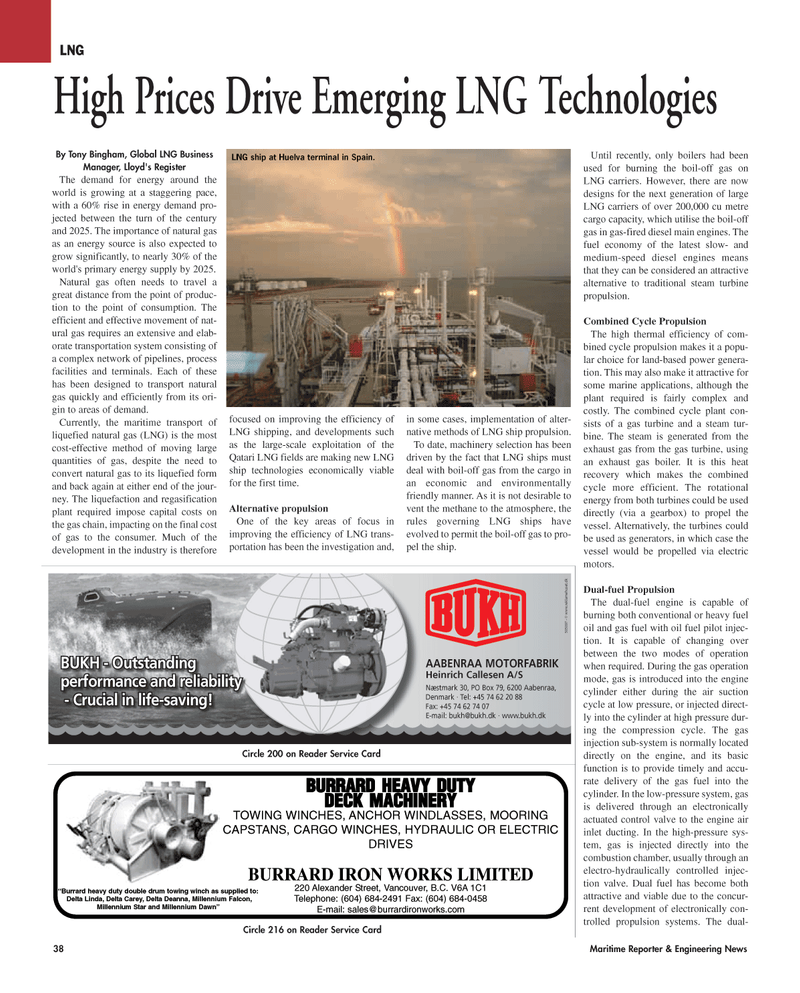
Page 38: of Maritime Reporter Magazine (April 2006)
The Offshore Industry Annual
Read this page in Pdf, Flash or Html5 edition of April 2006 Maritime Reporter Magazine
38 Maritime Reporter & Engineering News
By Tony Bingham, Global LNG Business
Manager, Lloyd's Register
The demand for energy around the world is growing at a staggering pace, with a 60% rise in energy demand pro- jected between the turn of the century and 2025. The importance of natural gas as an energy source is also expected to grow significantly, to nearly 30% of the world's primary energy supply by 2025.
Natural gas often needs to travel a great distance from the point of produc- tion to the point of consumption. The efficient and effective movement of nat- ural gas requires an extensive and elab- orate transportation system consisting of a complex network of pipelines, process facilities and terminals. Each of these has been designed to transport natural gas quickly and efficiently from its ori- gin to areas of demand.
Currently, the maritime transport of liquefied natural gas (LNG) is the most cost-effective method of moving large quantities of gas, despite the need to convert natural gas to its liquefied form and back again at either end of the jour- ney. The liquefaction and regasification plant required impose capital costs on the gas chain, impacting on the final cost of gas to the consumer. Much of the development in the industry is therefore focused on improving the efficiency of
LNG shipping, and developments such as the large-scale exploitation of the
Qatari LNG fields are making new LNG ship technologies economically viable for the first time.
Alternative propulsion
One of the key areas of focus in improving the efficiency of LNG trans- portation has been the investigation and, in some cases, implementation of alter- native methods of LNG ship propulsion.
To date, machinery selection has been driven by the fact that LNG ships must deal with boil-off gas from the cargo in an economic and environmentally friendly manner. As it is not desirable to vent the methane to the atmosphere, the rules governing LNG ships have evolved to permit the boil-off gas to pro- pel the ship.
Until recently, only boilers had been used for burning the boil-off gas on
LNG carriers. However, there are now designs for the next generation of large
LNG carriers of over 200,000 cu metre cargo capacity, which utilise the boil-off gas in gas-fired diesel main engines. The fuel economy of the latest slow- and medium-speed diesel engines means that they can be considered an attractive alternative to traditional steam turbine propulsion.
Combined Cycle Propulsion
The high thermal efficiency of com- bined cycle propulsion makes it a popu- lar choice for land-based power genera- tion. This may also make it attractive for some marine applications, although the plant required is fairly complex and costly. The combined cycle plant con- sists of a gas turbine and a steam tur- bine. The steam is generated from the exhaust gas from the gas turbine, using an exhaust gas boiler. It is this heat recovery which makes the combined cycle more efficient. The rotational energy from both turbines could be used directly (via a gearbox) to propel the vessel. Alternatively, the turbines could be used as generators, in which case the vessel would be propelled via electric motors.
Dual-fuel Propulsion
The dual-fuel engine is capable of burning both conventional or heavy fuel oil and gas fuel with oil fuel pilot injec- tion. It is capable of changing over between the two modes of operation when required. During the gas operation mode, gas is introduced into the engine cylinder either during the air suction cycle at low pressure, or injected direct- ly into the cylinder at high pressure dur- ing the compression cycle. The gas injection sub-system is normally located directly on the engine, and its basic function is to provide timely and accu- rate delivery of the gas fuel into the cylinder. In the low-pressure system, gas is delivered through an electronically actuated control valve to the engine air inlet ducting. In the high-pressure sys- tem, gas is injected directly into the combustion chamber, usually through an electro-hydraulically controlled injec- tion valve. Dual fuel has become both attractive and viable due to the concur- rent development of electronically con- trolled propulsion systems. The dual-
BURRARD HEAVY DUTY
DECK MACHINERY
TOWING WINCHES, ANCHOR WINDLASSES, MOORING
CAPSTANS, CARGO WINCHES, HYDRAULIC OR ELECTRIC
DRIVES
BURRARD IRON WORKS LIMITED 220 Alexander Street, Vancouver, B.C. V6A 1C1
Telephone: (604) 684-2491 Fax: (604) 684-0458
E-mail: [email protected] “Burrard heavy duty double drum towing winch as supplied to:
Delta Linda, Delta Carey, Delta Deanna, Millennium Falcon,
Millennium Star and Millennium Dawn”
Circle 216 on Reader Service Card
Circle 200 on Reader Service Card
AABENRAA MOTORFABRIK
Heinrich Callesen A/S
Næstmark 30, PO Box 79, 6200 Aabenraa,
Denmark · Tel: +45 74 62 20 88
Fax: +45 74 62 74 07
E-mail: [email protected] · www.bukh.dk 505097 - © w w w .r ek lamehuset.dk
BUKH - Outstanding performance and reliability - Crucial in life-saving!
LNG
High Prices Drive Emerging LNG Technologies
LNG ship at Huelva terminal in Spain.
MR APRIL2006 #5 (33-40).qxd 4/3/2006 4:16 PM Page 38

 37
37

 39
39
